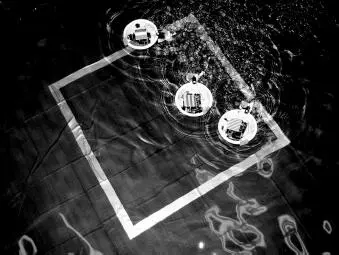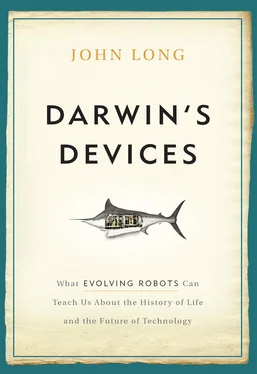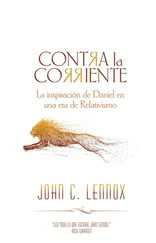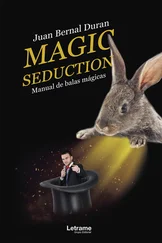But this expectation—this prediction—even though it is based on biomechanical and phylogenetic data, isn’t satisfying because it leaves so many questions unanswered. Are the proxies for stiffness and speed reasonable? Is the phylogenetic tree accurate? What other parts of the body, like muscles and shape, influence stiffness and speed? Do we find only a weak correlation because other parts of the species are different too? Would the correlation hold up if we could measure top speeds seen in the wild? Might stiffness also impact other parts of swimming performance, like acceleration and turning? What are the trade-offs in performance with increased speed? And worst of all, these questions don’t even speak to the evolutionary question of the dynamic process of adaptation.
When we ask why vertebral columns evolved from notochords, we are asking about adaptation. For biologists adaptation is the process by which natural selection acts over generational time to alter—to evolve—the characteristics of a population of organisms. Evolution by natural selection—as proposed by Darwin and supported since his time by thousands of experimental and observational tests—happens when the following conditions are met: (1) a feature, like the backbone, varies from individual to individual; (2) genes, at least in part, code the feature and its variations; and (3) the feature’s variations impact how individual organisms behave, survive, and reproduce relative to others in that population. When these three conditions are in place, what we see as we watch a population over time is that some individuals are better at making babies than are others. Because of these individual differences in reproductive output, as individuals and generations die, the population looks different, physically and genetically, from what it once looked like. This change over time is what Darwin called “descent with modification” and what we now call “evolution by natural selection.”

FIGURE 1.1. Evolving robots. Three autonomous, fish-like robots compete with each other for food. Because the swimming mode, sensory system, and brain of these robots are based on the tadpole-shaped larvae of sea squirt chordates, we call them “Tadros,” short for “tadpole robots.” Each Tadro has for its axial skeleton a notochord of differing stiffness. The stiffness of the notochord controls the swimming performance of the Tadro. Stiffness of the notochord is genetically coded and can, therefore, evolve from one generation to the next.
Like a clumsy criminal, adaptation leaves behind many clues in the DNA and anatomy of extinct and living species. But adaptation never leaves behind witnesses or a surveillance tape. Biologists inevitably have to guess at the process of evolution. The best guesses about what went on come from reconstructing the events. Using the clues—the physical evidence—good investigators can piece together a step-by-step sequence of places, agents, and interactions that most likely caused the outcome.
And what can we do to test this sequence? We can build models, let them run, and see if their behavior matches our predictions based on our evolutionary reconstruction. But we can also do one better: let the models evolve. This idea is what would ultimately lead us to invent something my students, collaborators, and I came to call Tadros (Figure 1.1). Starting with those little autonomous robots—not much more than a small computer in a bowl—we were about to embark on a journey of considerable discovery that would help us understand not just what a backbone does for a marlin, but what evolution can do for technology, and what technology can do for our knowledge of the history of life. Which is to say, Tadros themselves would be the best answer to the question: what do robots have to do with biology?
Chapter 2
THE GAME OF LIFE
“GREAT IS THE POWER OF STEADY MISINTERPRETATION.” This lament by Charles Darwin, from his sixth and final edition of The Origin of Species in 1872, summed up years of simmering frustration. Many of his critics and even some of his well-meaning champions had oversimplified his particular theory (other theories existed at the time) of descent with modification, what we now call evolution. The oversimplification was this: descent with modification has a single cause, natural selection.
Although natural selection was Darwin’s most important insight, he recognized and stated repeatedly in print that while it was the primary mechanism of change, it was not the only one. “Evolution by natural selection” was the phrase that I used in the previous chapter to define “adaptation.” Though that may be true, it’s only part of the evolutionary picture. Oops. Because I didn’t talk about other kinds of causal mechanisms—like mutation, recombination, genetic drift, and assortative mating—I’m one of the oversimplifiers. Let me make amends here to get you ready for the lifelike complexities of evolving robots.
I think that Darwin, a keen observer, would’ve loved watching our evolving robots. With them we can show what evolution looks like when selection is dominant, on the one hand, and when it takes a backseat to other evolutionary mechanisms, on the other. We can use robots to look at evolutionary processes, those ongoing, real-time, cause-and-effect interactions of autonomous agents with their environment—at any specific place and time. That is, we can become spectators at the greatest game on Earth: the game of life.
Think of it this way: life is a game, a never-ending contest played on the world’s stage. But the players are not often locked in open combat. Although a great white shark hunting a California sea lion makes for dramatic theater on Animal Planet’s “Shark Week,” in the real game of life most of the players never meet. Instead, each player is more like a plodding decathlete, doing ten different sports in quick succession and often at the same time. Each mobile, autonomous animal navigates its landscape, finds food or hunts for it, figures out how or if to eat what it’s found, detects and escapes threats, seeks and selects mates, finds shelter if it can, and makes offspring. Winners are those who survive long enough to reproduce. Among the winners, the champions are those who have the most children. The game of life is called evolution, and robots are allowed to play.
RULES OF PLAY
Evolution is one of the simplest games on the planet. It has only three rules:
* You score points for each child you create.
* You score bonus points if your children make offspring of their own.
* You can use any means to make children and to help your children make children.
Just because the rules are simple doesn’t mean that the strategies are simple too. Some players may realize that cooperation provides more eyes, ears, and noses for collecting food and avoiding predators. [1] A cautionary note: I’m being flippant here in several ways. First, the list of behaviors in this paragraph is vertebrate-centric. Second, it’s unlikely that any individual vertebrate alters behavior very much in its own lifetime; big changes in behavioral strategy occur over generational time.
Other players may figure out that if they don’t have to raise their offspring, they can spend much more time making them. Some may discover that, through deceit or cuckoldry, they can have others raise their children. Others, still, might focus on collecting and protecting the resources that they need to raise their children. Players may also figure out that selecting the right mate can make the difference between success and failure.
Читать дальше













